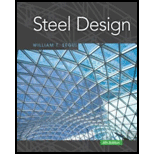
Steel Design (Activate Learning with these NEW titles from Engineering!)
6th Edition
ISBN: 9781337094740
Author: Segui, William T.
Publisher: Cengage Learning
expand_more
expand_more
format_list_bulleted
Question
Chapter 3, Problem 3.7.2P
To determine
(a)
The size of threaded rod using Load and Resistance Factor Design (LRFD) method when the load is not moving.
To determine
(b)
The size of threaded rod using LRFD when the load is kept at random locations.
Expert Solution & Answer
Trending nowThis is a popular solution!

Students have asked these similar questions
A W14X120 is used as a tension member in atruss. The flanges of the member are connected to a gusset plate by ¾ inch boltas shown below. Use A36 steel with Fy=36 ksi and Fu=58 ksi
Determine the Yielding Capacity of the section based on LRFD (kips)
Determine the Tensile Rupture capacity of the section based on LRFD
Determine the Demand to Governing Capacity Ratio (based on yielding and rupture only) if the Demand load carried by the section are DL=200 kips LL=400 kips use LRFD
For the clevis connection shown, determine the shear stress in the 23-mm-diameter bolt for an applied load of P = 165 kN.
O 141 MPa
O 211 MPa
O 167 MPa
O 120 MPa
O 199 MPa
Clevis
J 6
The cast iron bearing seat in the picture is bolted to the steel beam of the ceiling bracket and supports the gravity load.
Use M20 coarse thread ISO class 8.8 bolts with a thickness of 3.4 mm
The steel washers are placed under the bolt head and nut. The flange of this bracket is 20 mm thick, the shaft
The elastic modulus of the bearing is 135 GPa.
(a) Assuming this is a permanent joint and the fasteners are lubricated when assembled, find the required wrench torque.
(b) If the gravity load is 15 kN, try to find the load factor n of the design.
Chapter 3 Solutions
Steel Design (Activate Learning with these NEW titles from Engineering!)
Ch. 3 - Prob. 3.2.1PCh. 3 - Prob. 3.2.2PCh. 3 - Prob. 3.2.3PCh. 3 - Prob. 3.2.4PCh. 3 - Prob. 3.2.5PCh. 3 - Prob. 3.2.6PCh. 3 - Prob. 3.3.1PCh. 3 - Prob. 3.3.2PCh. 3 - Prob. 3.3.3PCh. 3 - Prob. 3.3.4P
Ch. 3 - Prob. 3.3.5PCh. 3 - Prob. 3.3.6PCh. 3 - Prob. 3.3.7PCh. 3 - Prob. 3.3.8PCh. 3 - Prob. 3.4.1PCh. 3 - Prob. 3.4.2PCh. 3 - Prob. 3.4.3PCh. 3 - Prob. 3.4.4PCh. 3 - Prob. 3.4.5PCh. 3 - Prob. 3.4.6PCh. 3 - Prob. 3.5.1PCh. 3 - Prob. 3.5.2PCh. 3 - Prob. 3.5.3PCh. 3 - Prob. 3.5.4PCh. 3 - Prob. 3.6.1PCh. 3 - Prob. 3.6.2PCh. 3 - Prob. 3.6.3PCh. 3 - Select an American Standard Channel shape for the...Ch. 3 - Prob. 3.6.5PCh. 3 - Use load and resistance factor design and select a...Ch. 3 - Select a threaded rod to resist a service dead...Ch. 3 - Prob. 3.7.2PCh. 3 - Prob. 3.7.3PCh. 3 - Prob. 3.7.4PCh. 3 - Prob. 3.7.5PCh. 3 - Prob. 3.7.6PCh. 3 - Prob. 3.8.1PCh. 3 - Prob. 3.8.2PCh. 3 - Prob. 3.8.3PCh. 3 - Prob. 3.8.4PCh. 3 - Prob. 3.8.5P
Knowledge Booster
Similar questions
- A W14X120 is used as a tension member in atruss. The flanges of the member are connected to a gusset plate by 3/4 inch boltas shown below. Use A36 steel with Fy-36 ksi and Fu=58 ksi Determine the Yielding Capacity of the section based on LRFD (kips) Determine the Tensile Rupture capacity of the section based on LRFD Determine the Demand to Governing Capacity Ratio (based on yielding and rupture only) if the Demand load carried by the section are DL=200 kips LL=400 kips use LRFD Properties and Dimension Ag=35.30 in^2 x = 6.24 in ry= 3.74 in d=14.5 in tf=0.94 in bf=14.7 in tw=0.59 in k=1.54 d=14.5 Y k1=1.5 bf=14.7 tf-0.94 X -tw=0.59 Harrow_forwardThe given beam is laterally supported at the ends and at the 1 3 points (points 1, 2, 3, and 4). The concentrated load is a service live load. Use Fy=50 ksi and select a W-shape. Do not check deflections. a. Use LRFD. b. Use ASD.arrow_forward
Recommended textbooks for you
 Steel Design (Activate Learning with these NEW ti...Civil EngineeringISBN:9781337094740Author:Segui, William T.Publisher:Cengage Learning
Steel Design (Activate Learning with these NEW ti...Civil EngineeringISBN:9781337094740Author:Segui, William T.Publisher:Cengage Learning

Steel Design (Activate Learning with these NEW ti...
Civil Engineering
ISBN:9781337094740
Author:Segui, William T.
Publisher:Cengage Learning